HOW TO GRAPH A PARABOLA IN INTERCEPT FORM
Subscribe to our ▶️ YouTube channel 🔴 for the latest videos, updates, and tips.
Intercept form equation of a parabola :
y = a(x - p)(x - q)
Characteristics of graph :
- The x-intercepts are p and q.
- The axis of symmetry is halfway between (p, 0) and (q, 0).
- The graph opens up if a > 0 and opens down if a < 0.
- To find y-intercept of the parabola, we apply x = 0
Example 1 :
Graph : y = -(x + 2)(x - 4)
Solution :
The equation of the parabola is in intercept form
y = a(x - p)(x - q)
where a = -1, p = -2, and q = 4.
Because a < 0, the parabola opens down.
The x-intercepts occur at (-2, 0) and (4, 0).
The axis of symmetry lies halfway between these points, at x = 1.
So, the x-coordinate of the vertex is x = 1 and the y-coordinate of the vertex is :
y = -(1 + 2)(1 - 4)
= -(3)(-3)
= 9
The graph of the equation is shown below.
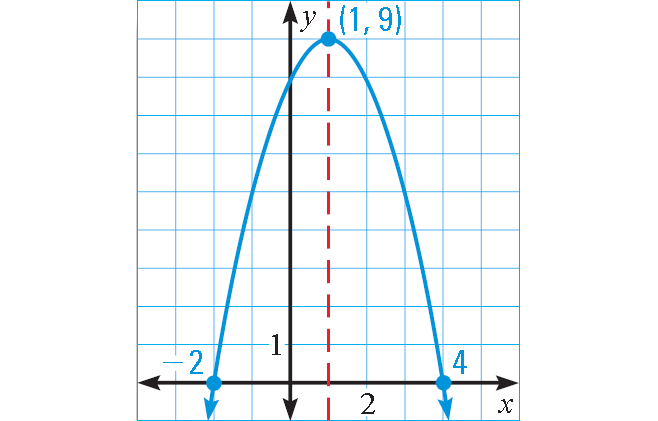
Example 2 :
Graph : y = (x + 2)(x - 3)
Solution :
The equation of the parabola is in intercept form
y = a(x - p)(x - q)
where a = 1, p = -2, and q = 3.
Because a > 0, the parabola opens up.
The x-intercepts occur at (-2, 0) and (3, 0).
The axis of symmetry lies halfway between these points, at x = 0.5.
So, the x-coordinate of the vertex is x = 0.5 and the y-coordinate of the vertex is :
y = (0.5 + 2)(0.5 - 3)
= (2.5)(-2.5)
= -6.25
The graph of the equation is shown below.
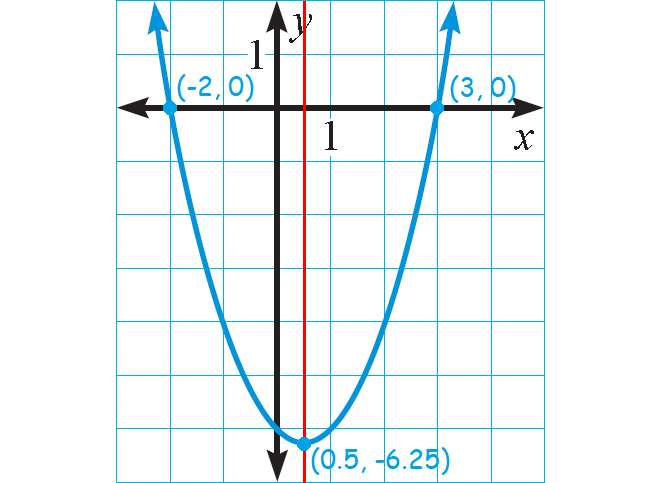
Example 3 :
Graph : y = (x - 4)(x + 2)
Solution :
The equation of the parabola is in intercept form
y = a(x - p)(x - q)
where a = 1, p = 4, and q = -2.
Because a > 0, the parabola opens up.
The x-intercepts occur at (4, 0) and (-2, 0).
Halfway of x-intercepts = 4 + (-2) / 2 ==> 1
The axis of symmetry lies halfway between these points, at x = 1.
So, the x-coordinate of the vertex is x = 1 and the y-coordinate of the vertex is :
y = (1 - 4)(1 + 2)
= (-3)(3)
= -9
The graph of the equation is shown below.
y -intercept :
y = (x - 4)(x + 2)
When x = 0
y = (0 - 4) (0 + 2)
y = -8
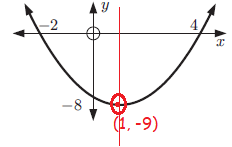
Example 4 :
Graph : y = -(x - 4)(x + 2)
Solution :
The equation of the parabola is in intercept form
y = a(x - p)(x - q)
where a = -1, p = 4, and q = -2.
Because a < 0, the parabola down.
The x-intercepts occur at (4, 0) and (-2, 0).
Halfway of x-intercepts = 4 + (-2) / 2 ==> 1
The axis of symmetry lies halfway between these points, at x = 1.
So, the x-coordinate of the vertex is x = 1 and the y-coordinate of the vertex is :
y = -(1 - 4)(1 + 2)
= -(-3)(3)
= 9
y -intercept :
y = -(x - 4)(x + 2)
When x = 0
y = -(0 - 4) (0 + 2)
y = 8
The graph of the equation is shown below.
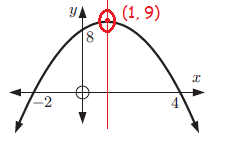
Example 5 :
Graph : y = 2(x + 3)(x + 5)
Solution :
The equation of the parabola is in intercept form
y = a(x - p)(x - q)
where a = 2, p = -3, and q = -5.
Because a > 0, the parabola opens up.
The x-intercepts occur at (-3, 0) and (-5, 0).
Halfway of x-intercepts = (-3) + (-5) / 2 ==> -4
The axis of symmetry lies halfway between these points, at x = -4.
So, the x-coordinate of the vertex is x = -4 and the y-coordinate of the vertex is :
y = 2(-4 + 3)(-4 + 5)
= 2(-1)(1)
= -2
y -intercept :
y = 2(x + 3)(x + 5)
When x = 0
y = 2(0 + 3)(0 + 5)
y = 2(3)(5)
y = 30
The graph of the equation is shown below.
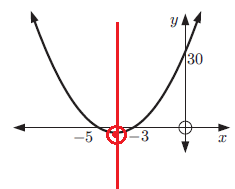
Example 6 :
Graph : y = -3x(x + 4)
Solution :
The equation of the parabola is in intercept form
y = a(x - p)(x - q)
where a = -3, p = 0, and q = -4.
Because a < 0, the parabola down.
The x-intercepts occur at (0, 0) and (-4, 0).
Halfway of x-intercepts = 0 + (-4) / 2 ==> -2
The axis of symmetry lies halfway between these points, at x = -2.
So, the x-coordinate of the vertex is x = -2 and the y-coordinate of the vertex is :
y = -3x(x + 4)
y = -3(-2)(-2 + 4)
y = 6(2)
y = 12
Vertex is at (-2, 12)
y -intercept :
y = -3x(x + 4)
When x = 0
y = 3(0)(0+4)
y = 0
The graph of the equation is shown below.
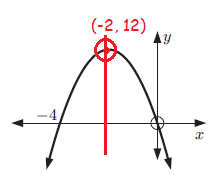
Subscribe to our ▶️ YouTube channel 🔴 for the latest videos, updates, and tips.
Kindly mail your feedback to v4formath@gmail.com
We always appreciate your feedback.
About Us | Contact Us | Privacy Policy
©All rights reserved. onlinemath4all.com

Recent Articles
-
GMAT Quantitative Reasoning Questions and Answers
Dec 27, 25 09:33 PM
GMAT Quantitative Reasoning Questions and Answers -
10 Hard SAT Math Questions (Part - 40)
Dec 25, 25 08:30 AM
10 Hard SAT Math Questions (Part - 40) -
10 Hard SAT Math Questions (Part - 41)
Dec 24, 25 07:58 PM
10 Hard SAT Math Questions (Part - 41)

